Pinhole camera in physics
The simplest camera in the world, the pinhole camera, consists of only one (as small as possible) hole. And yet it can be used to show and explain the physics of photographic imaging experimentally.
The principle of the pinhole camera is fundamentally ancient. Even Aristotle is said to have thought about optical images during a solar eclipse have: He sat under the canopy of trees and discovered numerous pictures of the Sun sickle. He realized that these were caused by the small gaps in the leaves as a direct image of the sun. As a camera obscura, the pinhole camera was then used by many artists to paint the most realistic landscape shots possible. Because the images are surprisingly sharp, but often very dark.
The pinhole camera - carry out your own physics experiment
For this simple, yet impressive experiment, you only need items that you already have in your household.
- With a slightly thicker needle, poke a hole in the center of a large piece of sturdy cardboard - this is your pinhole camera.
- With this cardboard you can project an inverted image, for example a candle, onto a piece of white paper. To do this, darken the room.
- However, the physics experiment becomes more impressive if you are in a room with a window on a sunny day.
- Stand or sit on the wall opposite the window.
- Now hold the cardboard with the hole vertically in the light and a piece of white paper in the shadow of the card behind the hole. The incident light casts an image (again upside down) of the window onto the white paper.
- Alternatively, you can of course throw the window image onto the opposite wall. The great sharpness of the picture is surprising.
- If you enlarge the hole in the cardboard with the tip of a pencil, for example, the image becomes lighter, but also more blurred.
The construction of a pinhole camera gives you completely new insights into the world of ...
By the way, you can build a "real" pinhole camera out of a shoebox or a round coffee tin. One side of the box or The box contains the hole (punch in the lid), on the other side you attach transparent greaseproof paper (attach with adhesive tape) as a screen. Make holes of different sizes out of cardboard that you can use as a cover in front of your pinhole camera.
The pinhole camera - this is how it works
To understand how the pinhole camera image comes about, access the ray model of the light in the physics return.
- The light rays come in straight lines from every point of the candle or window through the hole onto the paper.
- However, because the hole is so small, only a small part of this light reaches the white paper. In principle, one could even imagine that from every glowing point of the candle or of the window, only one (or only a few) rays of light fall on the paper. This is how the image is created.
- The picture is upside down because the light from the top of the window passes through the hole and then reaches the bottom of the picture. Light from the lower areas of the landscape reaches the top.
- With a small hole, the image is dark and sharp, because only a few light rays generate the individual image points.
- If you enlarge the hole, the picture becomes brighter. However, several rays of light now create an image point, which then becomes larger and therefore more blurred. This can be clearly interpreted as a cone of light: the narrower this cone, the sharper the image.
True or maybe not? In the 17th In the 19th century, there is said to have been such a camera obscura near a park. For a fee, distinguished visitors could go in there and watch the (more or less) amorous adventures of the park visitors. However, what was to be seen there is said to have only been staged. Because while the visitors stood in the dark room and stared spellbound at the (stimulating) pictures, their wallets were stolen from them.


